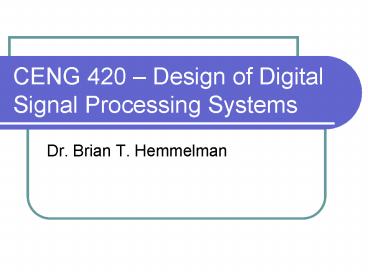CENG 420 Design of Digital Signal Processing Systems - PowerPoint PPT Presentation
1 / 26
Title:
CENG 420 Design of Digital Signal Processing Systems
Description:
Consumer Electronics Cell phones, set top box, video cameras. DSP Applications ... Locate R-wave (most noticeable feature) Remove baseline shift. Filter muscle noise ... – PowerPoint PPT presentation
Number of Views:181
Avg rating:3.0/5.0
Title: CENG 420 Design of Digital Signal Processing Systems
1
CENG 420 Design of Digital Signal Processing
Systems
- Dr. Brian T. Hemmelman
2
Introduction
- Historically, the signals and information most
engineering dealt with were always analog
(voltage, speed, etc.) - With the advent of the digital computer, new
possibilities opened up. - Mimic analog signal conditioning using digital
data - DSP can perform some tasks better than analog
methods, and can actually do tasks analog signal
processing cant (image processing, data
compression, etc.)
3
Typical DSP Signals
- Speech and voice
- Sound, music, audio
- Image, video
- Sonar, radar
- Satellite sensors (Infrared, UV, CO2, )
- Biomedical (ECG, EEG, EMG, MRI, ultrasound, )
4
DSP Applications
- Image Processing Robotic vision, FAX, satellite
weather - Instrumentation Spectrum analysis, noise
reduction - Speech Audio Speech recognition, equalization
- Military Radar processing, missile guidance
- Telecommunications Echo cancellation, video
conferencing, VoIP - Biomedical ECG analysis, patient monitoring
- Consumer Electronics Cell phones, set top box,
video cameras
5
DSP Applications
6
Advantages of DSP
- Guaranteed Accuracy Accuracy only limited by
bit length - Perfect Reproducibility No component
tolerances, no component drift due to temperature
or age - Greater Flexibility Functions and algorithms
can be changed through software - Superior Performance Adaptive filtering, linear
phase response - Some Data Naturally Digital Images, computer
files
7
Disadvantages of DSP
- Speed and Cost ADC/DAC, uProc
- Design Time Can be tricky
- Finite Word Length Issues
8
Key DSP Operations
- Convolution
- Correlation
- Filtering
- Transformations
- Modulation
9
Convolution
- Many uses, but a common use is determining a
systems output if system input and system
impulse response is known. For continuous system
10
Discrete Convolution
- We may however have a computer sampling a signal
so that we have discrete data. - So instead of continuous integration process we
have discrete summation.
- Practically speaking though we would have finite
sequences x(n) and h(n) of lengths N1 and N2
respectively, so this is then
11
Discrete Convolution
- Note that this is a series of multiplies-followed-
by-additions, so that this operation is
fundamentally a Multiply-Accumulate or MAC. - DSP systems are often benchmarked by the number
of MACs per second they perform. - DSP chips (and many FPGAs) have special internal
architectures that help perform MACs more
efficiently.
12
Correlation
- Correlation is essentially the same as
convolution (from a computational standpoint).
You just dont flip anything. - Instead of describing system output, correlation
tells us information about the signals.
13
Correlation
- Cross-correlation function
- Tells you a measure of similarities between two
signals. - Application Identifying radar return signals
14
Correlation
15
Correlation
- More than one definition of cross-correlation
- One definition for two N-length sequences
16
Correlation
- Autocorrelation function
- Correlate a signal with itself.
- Helps find periodicity in signals.
17
Correlation
18
Digital Filters
- High-pass, low-pass, bandpass, etc.
- Basically same idea as analog filters.
- FIR filter form
- x(n) is input
- y(n) is output
- h(k) are filter coefficients
19
Digital Filters
20
Discrete Transformations
- Often we want to find the frequency components of
a signal and/or need to go back and forth between
the time and frequency domain. - The most common technique is the DFT (not DTFT)
21
Compact Disc Example
- Both channels are sampled and mixed for storage.
- Dual channel data is encoded with a Reed-Solomon
encoder to fix burst errors (e.g. scratches). - To be more suitable for optical storage
Eight-to-Fourteen Modulation (EFM) is used.
22
Compact Disc Example
- Optical signal picked off CD and demodulated.
- Reed-Solomon error correction and concealment is
performed. - Dual-channel data is oversampled (4x) and split
into left and right channels. - Digital data is converted to analog voltage and
lowpass filtered.
23
Fetal ECG Monitoring
- Track babys heart activity through electrical
potentials on body surface. - Some key features
- ST segment
- Ratio of T amplitude to QRS amplitude
- Width of QRS complex
24
Fetal ECG Monitoring
Cardiotocogram (CTG)
25
Fetal ECG Monitoring
- These signals are quite susceptible to noise from
power supplies, muscle artifacts, poor
connections, etc. - Typical approach
- Remove 50/60 Hz noise
- Locate R-wave (most noticeable feature)
- Remove baseline shift
- Filter muscle noise
- Identify ST and PR segments
26
Fetal ECG Monitoring



















![Global Digital Signal Processors [DSP] Market Forecast & Analysis (2011-2016) PowerPoint PPT Presentation](https://s3.amazonaws.com/images.powershow.com/6327373.th0.jpg?_=20190226012)











